Did you know that Pigeon Key was once a bustling town in the early 1900s during the construction of the Florida Keys Overseas Highway?
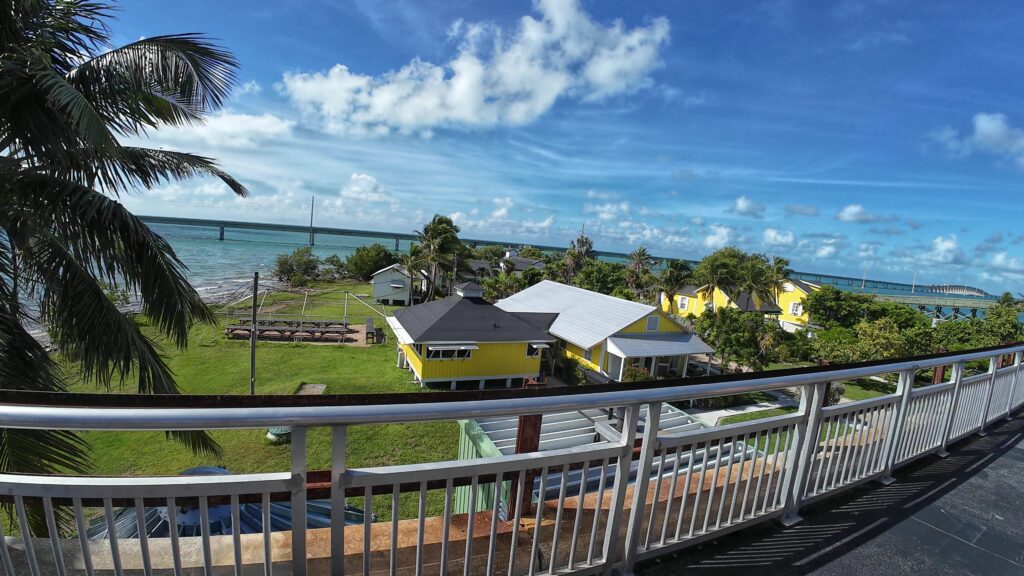
Introduction
Pigeon Key and the Old 7 Mile Bridge are gems that are often overlooked by visitors to the Florida Keys. However, they hold a special place in the history of this beautiful region. This is Darrell and Erin on Travel with D and E.
Join us as we take on the challenge of exploring the hidden gem of Pigeon Key in the Florida Keys and the Old 7 Mile Bridge—let’s see what secrets we can uncover!
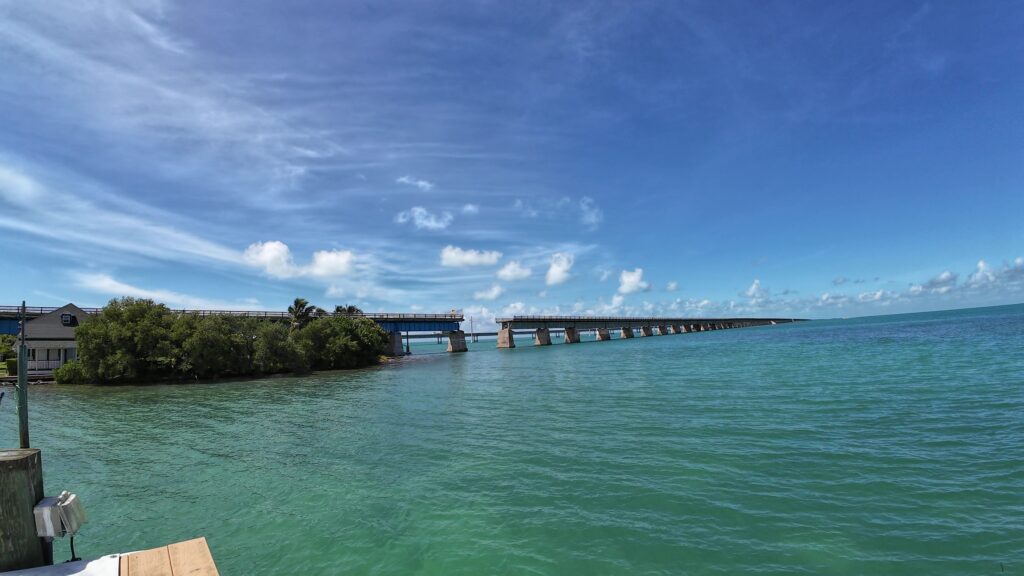
Pigeon Key and the 7-Mile Bridge
When people think of the Florida Keys, they usually think of Key West, Islamorada, or Marathon. People rarely consider Pigeon Key and the Old 7 Mile Bridge as must-visit destinations. And that’s exactly what makes it so special – it’s off the beaten path. You won’t find any crowded tourist traps or overpriced restaurants here. Instead, you’ll find a tranquil atmosphere, steeped in history and natural beauty.
History of Pigeon Key and the 7-Mile Bridge
Pigeon Key has a rich history dating back to the early 20th century when it was used as a construction camp for the Florida Keys Over-Sea Railroad. The railroad, completed in 1912, was an engineering marvel in its time. It connected the Florida Keys to the mainland like never before. And, Pigeon Key was right at the heart of it all.
Henry Flagler, a visionary entrepreneur and oil magnate, envisioned connecting the Florida Keys to the mainland via a revolutionary railroad. His ambitious plan aimed to extend the Florida East Coast Railway all the way to Key West, with Pigeon Key serving as a crucial construction site. Flagler’s Folly was a nickname for the railroad project because many doubted the building of the railroad.
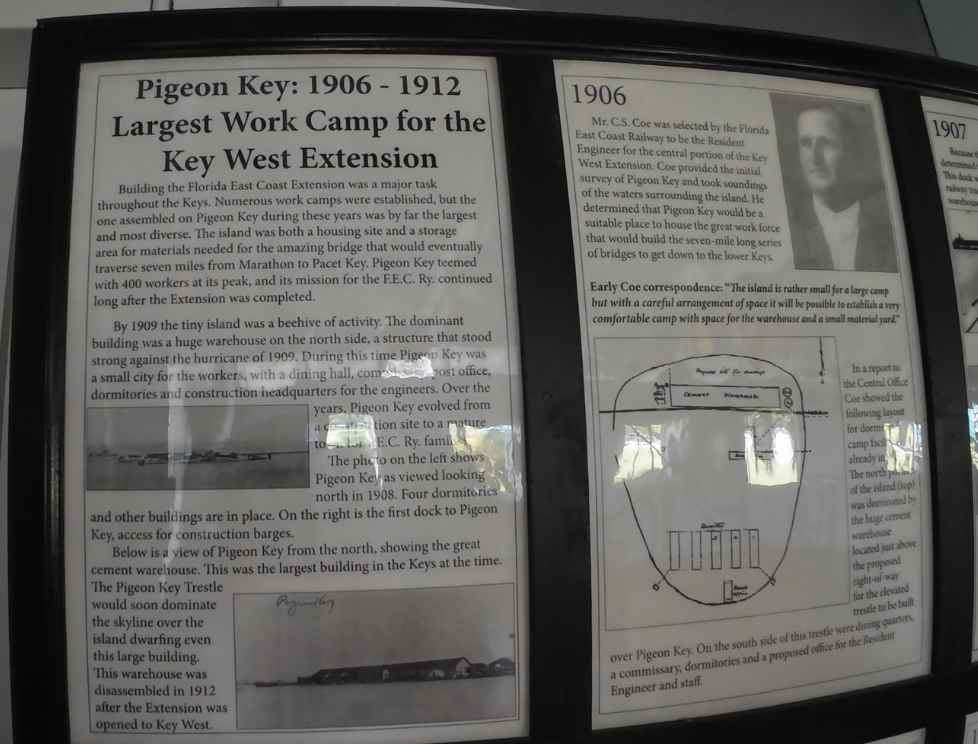
This tiny island, only 5 acres, served as a vital construction camp and headquarters for the Overseas Railroad project. The island buzzed with activity as workers toiled to lay tracks, build bridges, and establish essential infrastructure to support the railway operations.
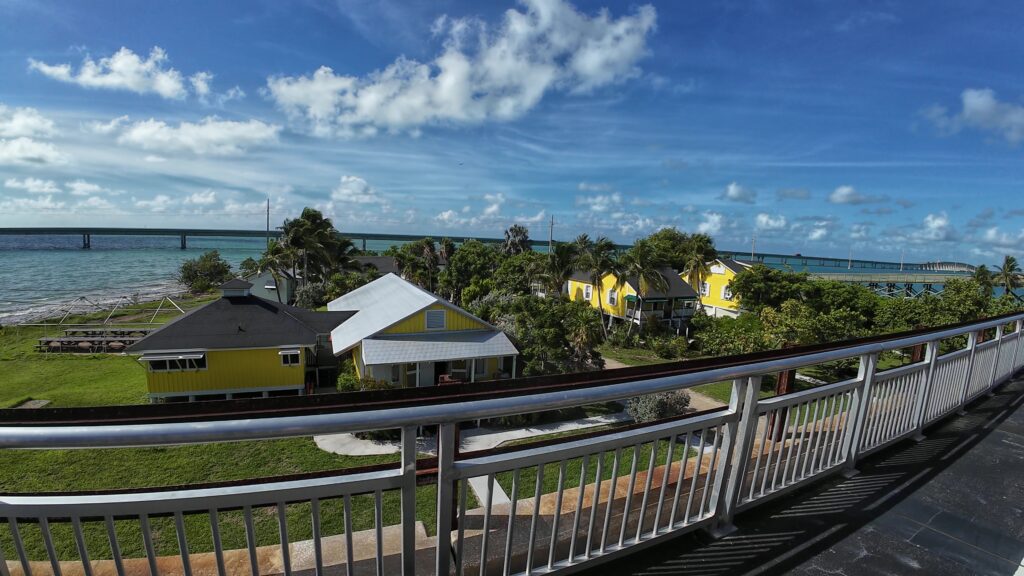
The railroad operated until 1935 when a huge hurricane with 200 mph wind came through.
Buildings on Pigeon Island
Several renovated, but original structures, remain on Pigeon Key for visitors to see.
Section Gang Quarters
The Section Gang Quarters is a building that was a bunkhouse for railroad workers. As you see the picture of the building here, let it bring your mind back to when 64 men lived here side-by-side and toiled 16 hours plus a day. These were real men! There were 4 of these buildings back in the day.
Today, children come here to learn about Pigeon Island and it’s role in building the railroad to Key West. Pigeon Island housed over 400 workers in its work camp at its peak.
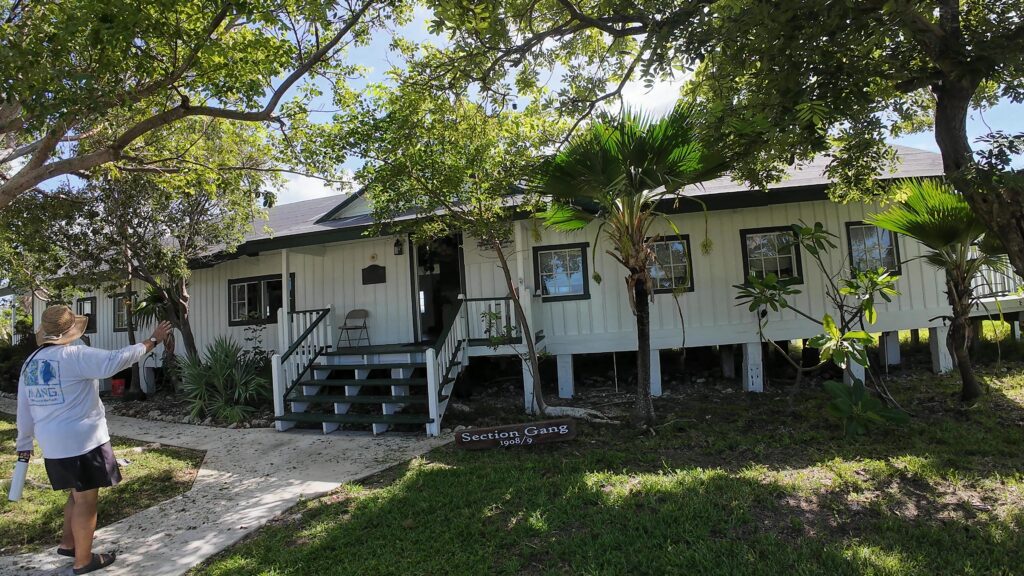
Now, the Pigeon Island Foundation utilize these buildings, and the entire island, for educational opportunities and as an environmental field station. These education opportunities include field trips for elementary, middle, and high school students. Summer camps and other research opportunities are available for graduate students and professors alike.
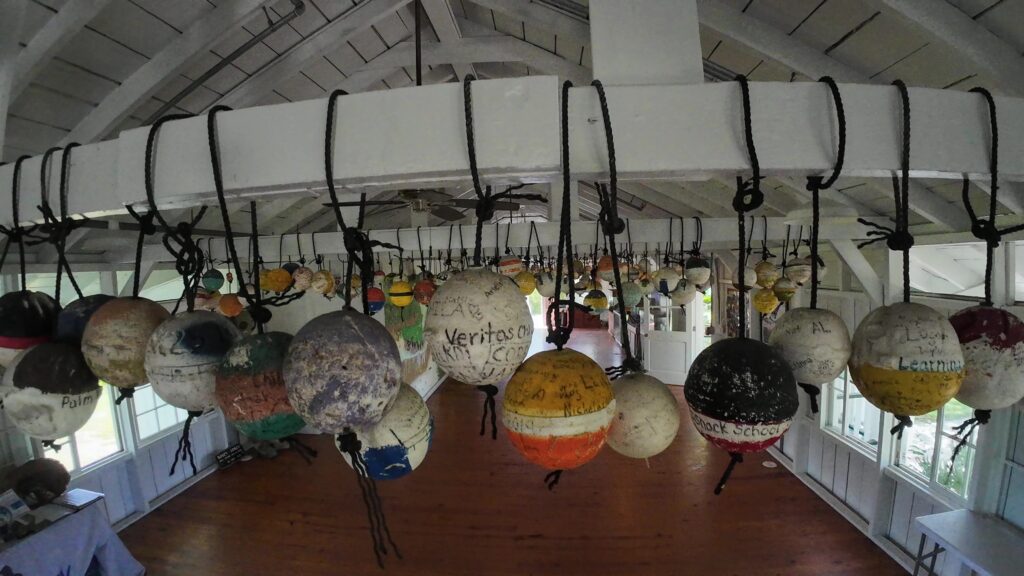
Commissary
The Commissary was a building built in 1912. Once the railroad was built, the island’s population changed from the construction mode into a bridge tender-maintenance camp. Groceries and other items for sale became available in a newly built Commissary to provide the needs of a more stationary workforce. The building is now the Pigeon Key Gift Shop.
Assistant Bridge Tenders House and Museum
In 1912, the work camp built a nice house for the Assistant Bridge Tender’s family. It now contains beautiful historical artifacts and is now the Pigeon Key and Railroad Museum.
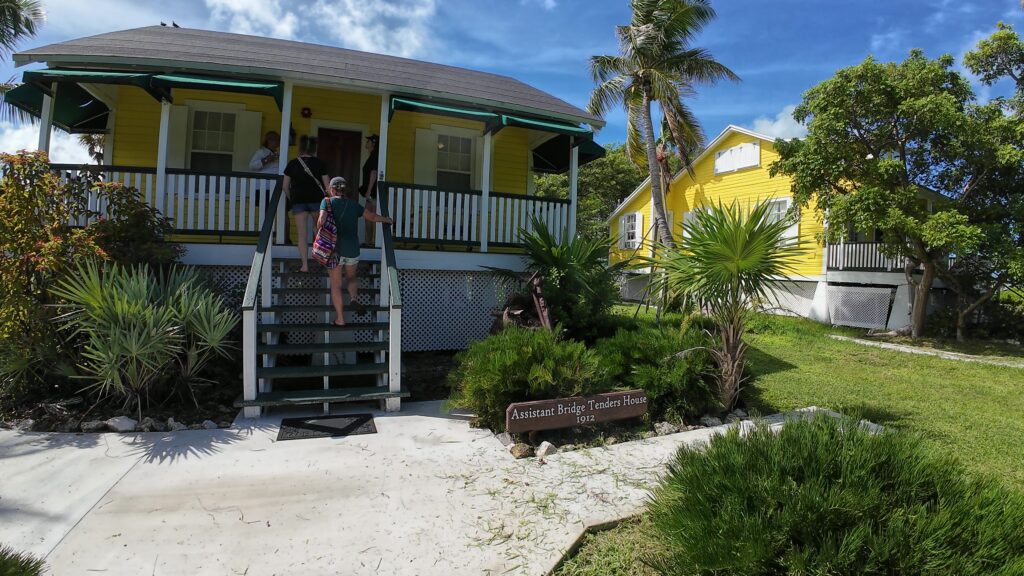
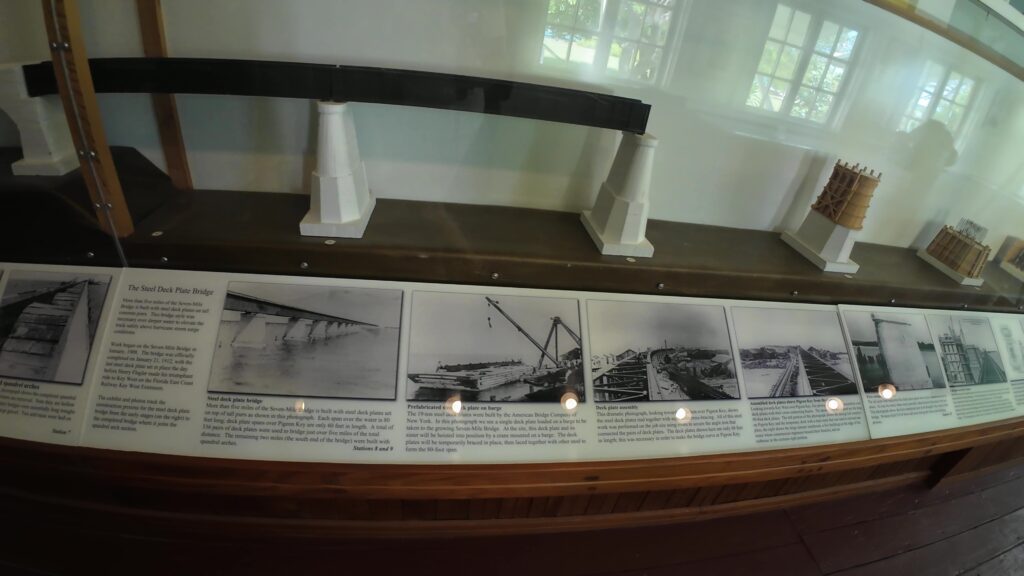
Honeymoon Cottage
The Honeymoon Cottage was built in 1952, next to the commissary building, which was built in 1912. Both buildings were originally intended to be temporary, and construction reused salvaged historical materials.
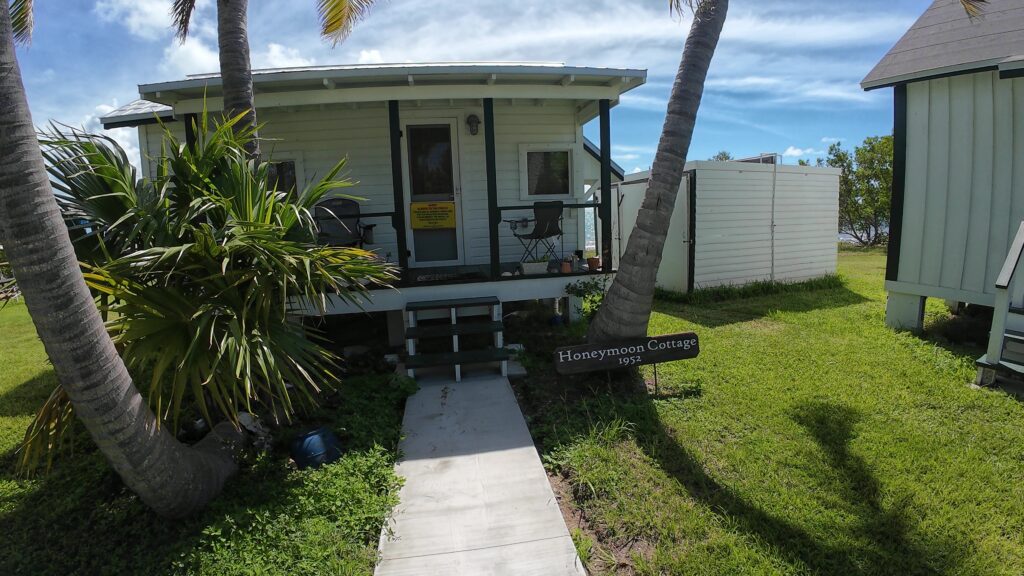
Paint Foreman’s House, Bridge Foreman’s House, Bridge Tender’s House
The camp built houses, from 1912 to 1916, to support the bridge tender-maintenance era after the original construction of the bridge. These historic buildings include the Bridge Tender’s, Bridge Foreman’s, and the Paint Foreman’s houses.
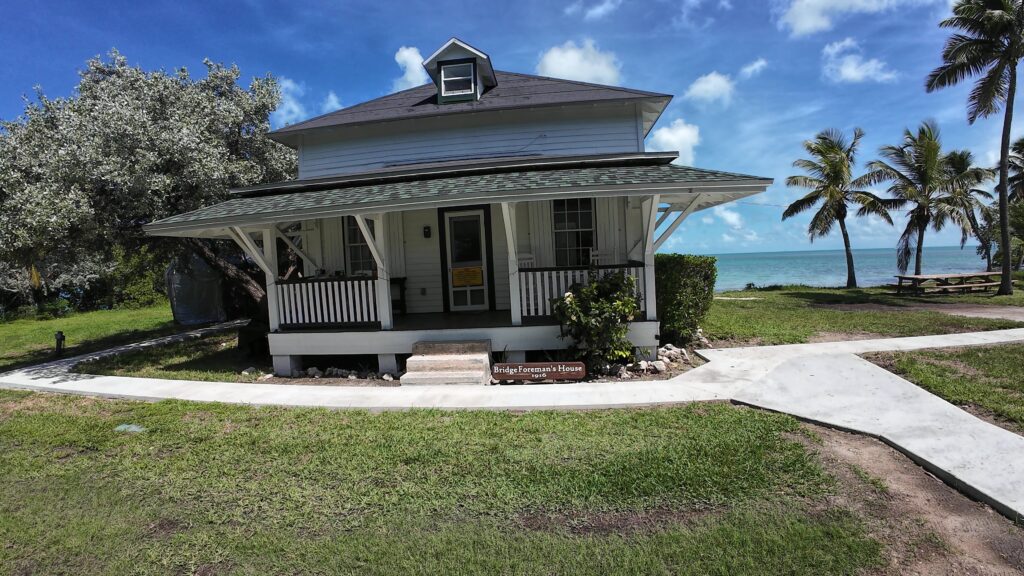
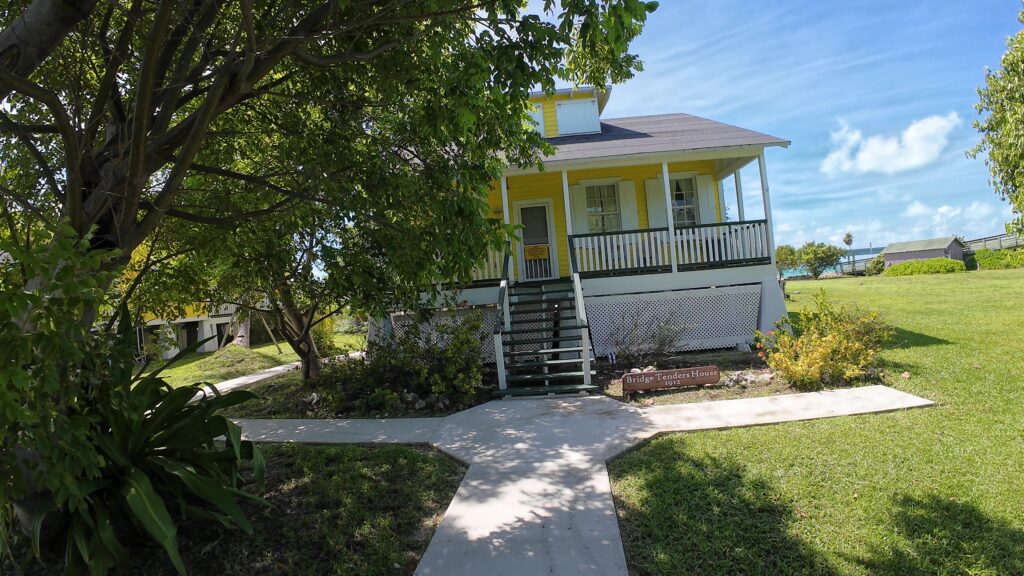
Boat Dock and Fishing Pier
A nice boat dock is available to stop at the island. Fishing is allowed off the pier assuming you have a valid fishing license. This is not original as you can tell.
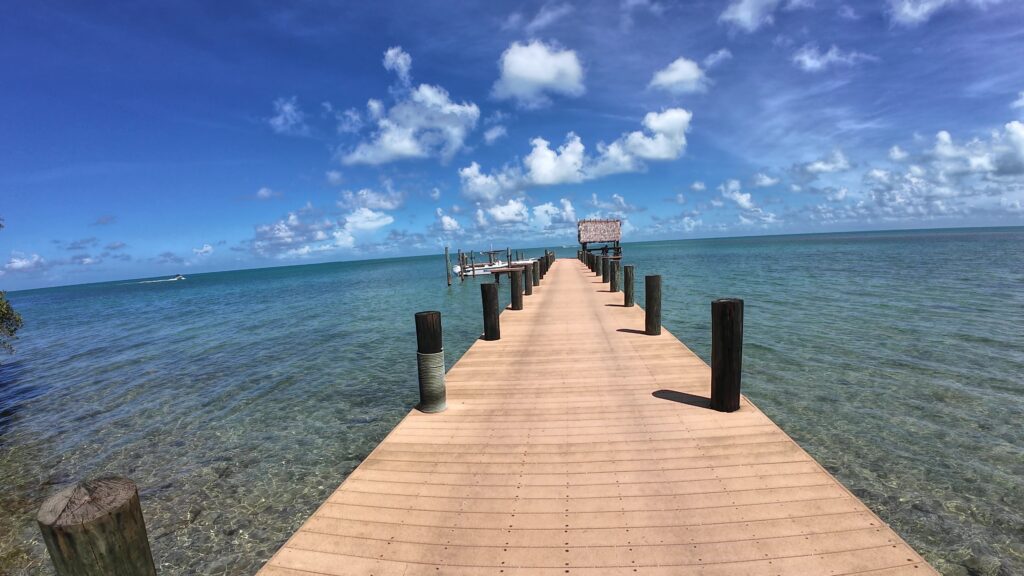
Saltwater Pool
They have a saltwater pool that houses an abundant array of fish including multiple sharks, groupers, snook, tarpon, green moray eels, and more. You can join the staff as the 1:00 PM tour ends to feed the fish living in the Salt Water Pool.
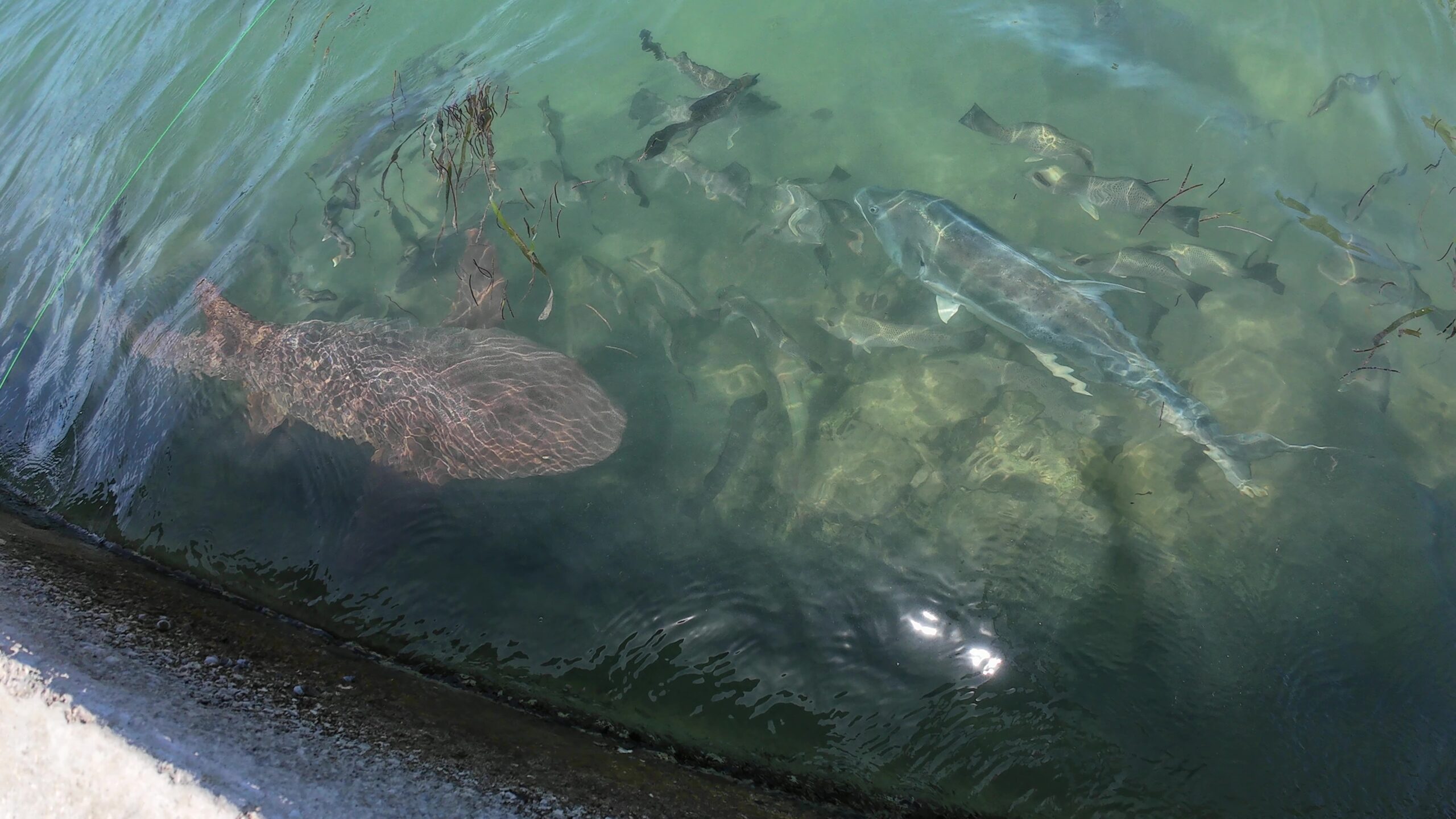
The Labor Day Hurricane
A Category 5 Labor Day hurricane in 1935 severely damaged the Florida Keys Overseas Railway. It destroyed over 40 miles of track and killed more than 500 people. The storm forced the railroad to abandon the line and was eventually sold to the State of Florida to repurpose the overseas railway for automobile traffic.
Re-Construction of the Old 7-Mile Bridge
Once it was sold to the State of Florida after the 1935 hurricane, the original bridge had to be remade as a two-way road for vehicular traffic, with handrails, and additional width added so two vehicles could pass each other going in opposite directions. The old railroad ties were re-used in the structure. The width of the bridge increased to a whopping 22 feet. It was called the Bridge of Mirrors because if you didn’t fold them in while passing another car, they would hit and break.
In 1938, the newly constructed Overseas Highway was unveiled, providing a direct route for travelers to drive between Miami and Key West without needing a ferry.

Historical Recognition
In recognition of its historical significance, Pigeon Key has been designated as a National Historic Landmark and is open to visitors who can explore the museum and learn about the island’s unique past. It
is also listed on the National Register of Historic Places. One thing is for sure, the history of the island and the old railroad are fascinating to learn and truly monumental in the development of Key West and the Florida Keys.
Restoration of the Old Seven Mile Bridge
In the summer of 2016, the easternmost 2-mile span of the old Seven Mile Bridge was shut down to pedestrians for a major renovation project. A $77 million rehabilitation project and maintenance program was budgeted covering a 30-year timeline. The first $41 million was spent over 5 years to complete the initial restoration efforts. These repairs included three coats of paint, the replacement of thousands of rusted metal plates, rivets, and structural steel, along with the installation of a new aluminum rail system. For structural integrity, 10-foot sections of the bridge were lifted, and the1936 I-beams were replaced. The reopening of the old seven mile bridge, or at least the 2-mile renovated span, occurred in early January 2022.
The not-for-profit Pigeon Key Foundation manages the island and works to preserve its rich heritage. Kelly McKinnon is the current executive director of the Pigeon Key Foundation. He has lived for 14 years on this historic small island beneath the Middle Florida Keys Old Seven Mile Bridge. Mr McKinnon is one of only four full-time island residents living on the island.
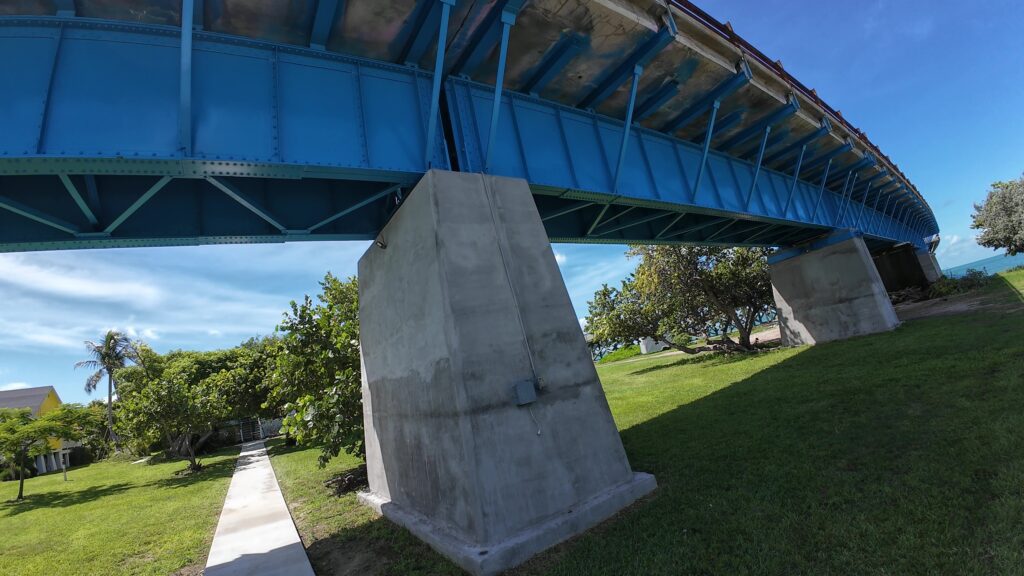
The New 7-Mile Vehicle Bridge
Eventually, Florida decided to retire the old bridge and construct a new seven mile bridge. It is the longest bridge in the Florida Keys and connects Marathon to the Lower Florida Keys. The new bridge was built using precast concrete sections and has 440 spans. Plans are being developed to replace this bridge in the upcoming years.
How to Get To Pigeon Key and the 7-Mile Bridge
What piqued our interest as we drove past the Pigeon Key and the 7-mile bridge a few times was the cool-looking blue and yellow train down from the pull-off on the main highway. Upon seeing that, we finally decided to stop and check it out. This train will bring you along the reconstructed portion of the 7-mile bridge to Pigeon Island. A historian either rides with you or is already there ready to give you a guided tour of the island. It was a cool way to get to the island!
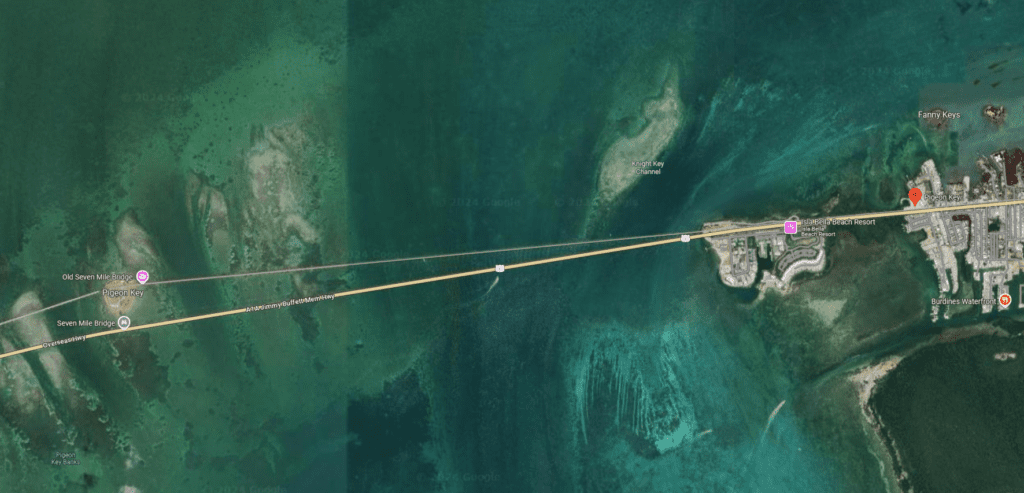
Other options are available including riding bicycles or even walking which is what a lot of people did.
Access to Pigeon Key and the Renovated Bridge
The iconic seven mile bridge, or at least the renovated 2-mile span, is now open to the public 7 days a week. There is a parking lot where the public may walk or ride their bicycle on the 2-mail span. Pigeon Key itself is not accessible except during operating hours between 9:00 AM to 5:00 PM.
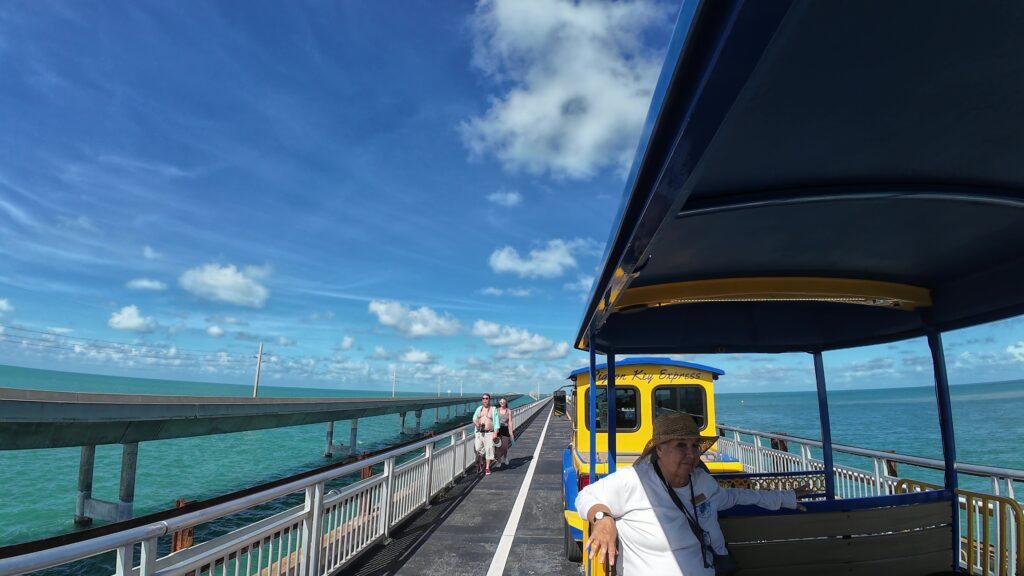
Guided Tours
Guided tours are available on Pigeon Key at 10:00 AM, 12:00 PM, and 2:00 PM. A train will ferry the tour guest out of the Faro Blanco Marina. If visitors accessing the island from the bridge would like to reserve a spot on one of the daily island tours, please call the Visitors Center at 305-743-5999.
This is a great tour for visitors of all ages.
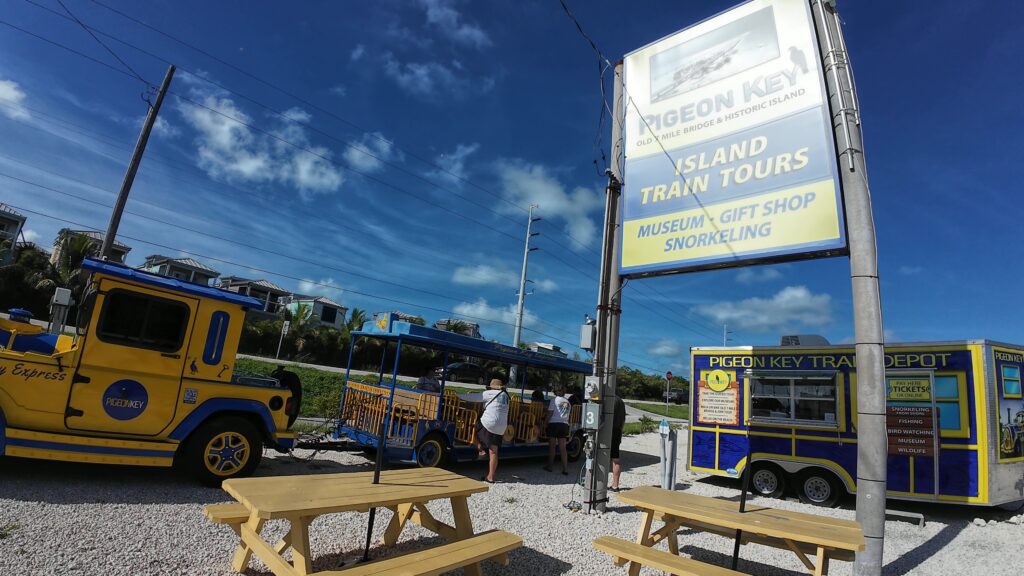
Reflections
As we explored Pigeon Key and the Old 7 Mile Bridge, I couldn’t help but feel grateful that I had stumbled upon this hidden gem. The scenery is breathtaking, the history is fascinating, and the atmosphere is peaceful and serene. It’s a truly unique experience that you won’t find anywhere else in the Florida Keys.
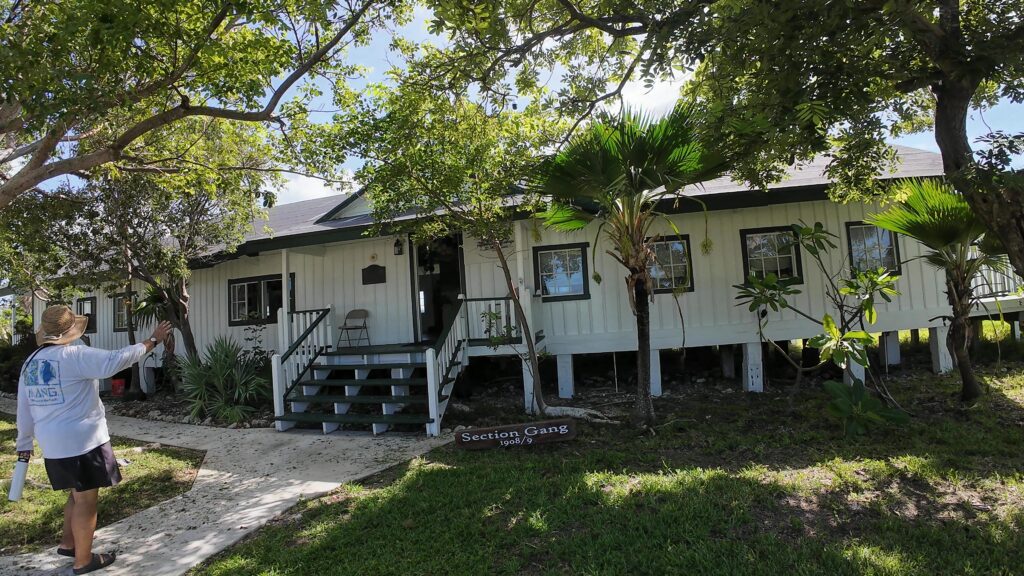
Conclusion
In conclusion, Pigeon Key and the Old 7 Mile Bridge are a hidden gem that deserves to be explored and appreciated. Whether you’re a history buff, a nature lover, or simply looking for a unique experience, this hidden gem has something to offer everyone.
Thanks for joining us on this journey to explore Pigeon Key and the Old 7 Mile Bridge! If you’ve been to this hidden gem before, I’d love to hear about your experiences in the comments below. And if you’re new here, consider subscribing for more posts on hidden gems in the Florida Keys including Key West’s Ghost and Legends Tour, Feeding Tarpon from the Dock at Robbie’s of Islamorada, Exploring the Beauty of Dry Tortugas National Park, Shark Valley in the Everglades, and more. Also, check out our many other travel destinations on our Travel with D and E site and our Travel with D and E YouTube channel.
FAQ
What is the significance of Pigeon Key in the history of the Florida Keys?
Pigeon Key holds significant historical importance in the development of the Florida Keys. Originally known as “Cayo Paloma,” it served as a vital base for the construction of Henry Flagler’s Overseas Railroad in the early 20th century, connecting mainland Florida to Key West. The laborers who worked on this ambitious project resided on Pigeon Key, enduring harsh conditions and contributing to the transformation of transportation infrastructure in the region.
How did the construction of the Overseas Railroad impact the development of Pigeon Key?
The construction of the Overseas Railroad played a crucial role in shaping the development of Pigeon Key. As a small, uninhabited island located in the Florida Keys, Pigeon Key was transformed into a bustling hub for workers and engineers during the railroad’s construction in the early 20th century. The island served as a critical base camp for laborers building Henry Flagler’s ambitious railway project, providing accommodations, dining facilities, and support services to thousands of workers.
Can visitors still explore Pigeon Key and the 7-Mile Bridge today?
Yes, visitors can still explore Pigeon Key and the 7-mile Bridge today. Pigeon Key, a historic island in the Florida Keys, is accessible by a renovated 2-mile span of the old 7-mile Bridge either on foot or bicycle or by a tram that picks visitors up at Faro Blanco Marina. The island features historic buildings, museums, and guided tours that showcase its significance in the development of the Overseas Railroad.
What preservation efforts are in place to protect the historical integrity of Pigeon Key and the 7-Mile Bridge?
Preservation efforts for Pigeon Key and the 7-Mile Bridge in the Florida Keys are of utmost importance to protect their historical integrity. Pigeon Key, a small island with significant cultural and architectural history, is listed on the National Register of Historic Places. Efforts to preserve this site include ongoing restoration projects aimed at maintaining original structures and artifacts, as well as educational programs to raise awareness about its historical significance.
The 7-Mile Bridge, an iconic structure connecting the Florida Keys, is also safeguarded through maintenance and restoration initiatives by the Department of Transportation. These preservation efforts not only ensure that future generations can appreciate the rich history of these sites but also contribute to tourism and economic development in the region.

Leave a Reply